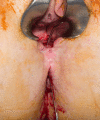Ileal-anal pouches: A review of its history, indications, and complications
- PMID: 31496616
- PMCID: PMC6710180
- DOI: 10.3748/wjg.v25.i31.4320
Ileal-anal pouches: A review of its history, indications, and complications
Abstract
The ileal pouch anal anastomosis (IPAA) has revolutionised the surgical management of ulcerative colitis (UC) and familial adenomatous polyposis (FAP). Despite refinement in surgical technique(s) and patient selection, IPAA can be associated with significant morbidity. As the IPAA celebrated its 40th anniversary in 2018, this review provides a timely outline of its history, indications, and complications. IPAA has undergone significant modification since 1978. For both UC and FAP, IPAA surgery aims to definitively cure disease and prevent malignant degeneration, while providing adequate continence and avoiding a permanent stoma. The majority of patients experience long-term success, but "early" and "late" complications are recognised. Pelvic sepsis is a common early complication with far-reaching consequences of long-term pouch dysfunction, but prompt intervention (either radiological or surgical) reduces the risk of pouch failure. Even in the absence of sepsis, pouch dysfunction is a long-term complication that may have a myriad of causes. Pouchitis is a common cause that remains incompletely understood and difficult to manage at times. 10% of patients succumb to the diagnosis of pouch failure, which is traditionally associated with the need for pouch excision. This review provides a timely outline of the history, indications, and complications associated with IPAA. Patient selection remains key, and contraindications exist for this surgery. A structured management plan is vital to the successful management of complications following pouch surgery.
Keywords: Crohn’s disease; Familial adenomatous polyposis; Ileal pouch; Restorative proctocolectomy; Ulcerative colitis.
Conflict of interest statement
Conflict-of-interest statement: No conflicts of interest exist.
Figures








References
-
- Nissen RR. Demonstrationen aus der operativen Chirurgie, no 39. Berlin Surgical Society. Zentralbl Chir. 1933;15:888.
-
- BEST RR. Anastomosis of the ileum to the lower part of the rectum and anus; a report on experiences with ileorectostomy and ileoproctostomy, with special reference to polyposis. Arch Surg. 1948;57:276–285. - PubMed
-
- Ravitch MM, Sabiston DC., Jr Anal ileostomy with preservation of the sphincter; a proposed operation in patients requiring total colectomy for benign lesions. Surg Gynecol Obstet. 1947;84:1095–1099. - PubMed
-
- Valiente MA, Bacon HE. Construction of pouch using pantaloon technic for pull-through of ileum following total colectomy; report of experimental work and results. Am J Surg. 1955;90:742–750. - PubMed
-
- Kock NG. Intra-abdominal "reservoir" in patients with permanent ileostomy. Preliminary observations on a procedure resulting in fecal "continence" in five ileostomy patients. Arch Surg. 1969;99:223–231. - PubMed
Publication types
MeSH terms
LinkOut - more resources
Full Text Sources
Medical
Research Materials
Miscellaneous

